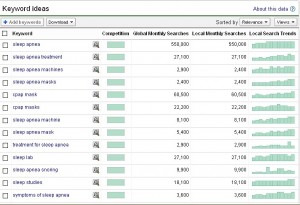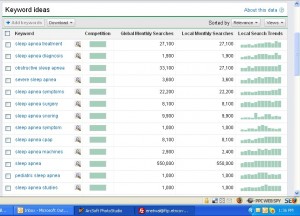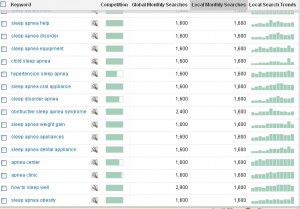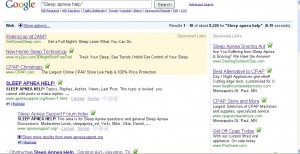The Google Key Word Tool is perhaps the most valuable of the free tools we are going to be discussing. In the past and in many dated online eBooks you will find references to the Overture Keyword Tool which is defunct, one of Yahoo’s biggest mistakes in my opinion. Today the world uses Google Free Keyword tool to explore and select keywords for a wide variety of purposes.
To access the tool, open your existing Google Adwords account or if you don’t have one go to Google and search for “Google Keyword Tool.”
Google has recently changed to layout of their site. The Keyword Tool is not immediately evident. You need to click on the “Opportunities” tab. When you do, any existing campaigns you are running will appear at the top of the left column. You may need to scroll down to see the second box in the left column which is titled, “Tools.”
Once there, just click on the Keyword Tool and you will be taken to the tool we will discuss today.
The tool permits two related but completely different functions. You can search for keywords on a particular web site, or you can do research on keywords related to a specific keyword phrase. We are going to focus on the later, but will discuss the former first.
In our last post we discussed how to drill down in the Google Directory to find a niche. In the final stages of that process we came to the end of the line, where we ran into articles related to our niche. I advised that we examine those sites to learn about out new niche, and to see if there were advertisers or not to determine if it were commercially viable.
Once we identified the most interesting sites already in the niche, we can take their url’s and plug them into the keyword tool.
In our search we drilled down ultimately to Sleep Apnea, and the top page ranked entry under it was the following: http://www.sleepapnea.org/
When we put this URL into the Google Keyword Tool we can see the keywords that led people to this site. This is valuable information, and can provide us with insights into the niche. Specifically it will help us identify the keyword phrases we will want to consider focusing our niche marketing on.
When Google Returns the results, it ranks them in accordance to Google’s sense of the most relevant Keyword Phrases. In this case, sleep apnea, sleep apnea treatment, sleep apnea machine, sleep apnea masks, cpap mask, cpap masks. etc.
Now I don’t know much about sleep apnea, but I now know that something called CPAP is up there in relevance. Depending on whatever niche you are exploring you may find similar surprises, that you will want to explore.
And while sleep apnea appeared as if it might be a small niche, we are beginning to see the possibility of even smaller niche in the form of masks and machines and possibly other treatment methodologies. These may be options that could be monetized.
Now is we go back and put in the phrase “Sleep Apnea” in the word or phrase box, we get a similar but different list.
It’s headed by the phrase, sleep apnea treatment, sleep apnea diagnosis, obstructive sleep apnea, severe sleep apnea, sleep apnea symptoms, etc.
Once again these are initially ranked by what Google sees as the most relevant term we entered into the box. If we want, we can click on the headers above any of the columns and get the results ranked in ascending or descending order by that column.
Its lead by the term Insomnia, followed by apnea, sleep apnea, apnea sleep, snoring, narcolepsy, sleep aid and so on. These are the terms that are related to sleep apnea that get the most traffic. We found a new term, narcolepsy that merits some examination and as we scroll down the list there are a few more interesting terms that we may not have thought of when we first started to explore sleep apnea.
This access to related terms is valuable. By taking them and using them in the keyword tool as new phrases we may find even more terms that we might otherwise miss altogether.
We won’t do that now, but you should with your niche studies.
We will discuss two additional items though.
The first is the competition graph.
If the bar graph is completely full, it is both good and bad news. The good is that the niche is actively being pursued by advertisers, which indicates a good chance that money can be made in this niche. The bad is that it is already a contested market so it will not be easy to break into the top without a major effort.
You may decide that you want to make that effort. If you are looking to use the internet to sell your existing product line, you may have no choice. However if you are looking for a new market to enter, you do have a choice and should use the following technique to identify a market that is both lucrative and that you have a chance to dominate.
I learned this approach originally through the Niche Profit Classroom. You can see a small banner ad of there’s in the upper right of the blog page. I found their entire program to be well worth the modest membership fee and can comfortably recommend them to you.
They outlined something they call the money market matrix. Since I learned it from them, I have heard similar approaches advocated by others as well. I will give you my short hand approach now.
Rather than focusing on the high end of the search results we are going to go down the list and focus on keywords that have 300 or more hits a month up to those that get about 2000 to 2500. This range is somewhat arbitrary and you can certainly go beyond it in either direction.
Your goal is not to find the most popular search term, it’s to find a frequently used search term that is relevant to your niche and/or product for which their are relatively few competitors. By relatively few my shorthand answer is 50,000 or less.
The term “Sleep Apnea” returned 800 results so we have to scroll down to the bottom of the second page of 100 results to get in range.
The top item on the screen capture above is the term, “sleep apnea help.”
The Google Keyword Tool tells us that it is getting an average of 1600 hits a month. That’s slightly over 50 a day. So while not huge, it’s likely a steady source of traffic interested in the topic. Next we are going to a new tab on our browser. There we will do a search using the regular Google search tool for “Sleep Apnea Help” being sure to include the quote marks. That way we will get the total number of results that use that precise term. It turns out that in this case the result is 8220 which is well under my threshold of 50,000 competing sites.
While I am there, I notice that there are a lot of ads, which tells me this is a solid keyword phrase I could hope to build upon. Note there are three ads on top of the organic search results and a full side panel as well.
The Google Keyword tool is an extremely valuable tool, with a number of additional features. I’ve tried to show you some of the basics as well as a strategy to put the information you can derive from the tool to work for you.
In my next post, we will explore Google Trends.





